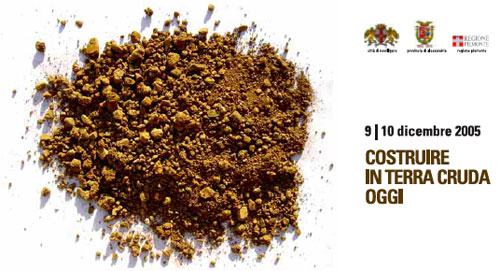
Building with Raw Earth Today: International Conference on the Preservation, Promotion and Protection of Earth Architecture. December 9-10, 2005. Download conference schedule [Italian Language]

Architecture, Art, Design, and Culture using of mud, clay, soil, dirt & dust.

Building with Raw Earth Today: International Conference on the Preservation, Promotion and Protection of Earth Architecture. December 9-10, 2005. Download conference schedule [Italian Language]

An Architecture for People: The Complete Works of Hassan Fathy reviews the ideas and designs of Egyptian architect Hassan Fathy (1900-1989), best known for his striking Architecture for the Poor (University of Chicago, 1973), which described his efforts to create the village of New Gourna for 7,000 displaced Egyptian peasants known as the Gourni. Fathy sought to empathize with their lifeworld and to find architectural means whereby the new village would sustain their traditional way of life yet at the same time make life better by drawing on sustainable technology.
Steele, an architect himself, presents Fathy’s built projects and discusses the design philosophy underlying his work. Steele’s book is a tribute to Fathy as a compassionate designer and as a master craftsman who held strongly to traditional values and beliefs at a time when the historical amnesia and standardization of Modernist architecture dominated.
“Node 1” is a conceptual architecture project by French Architect François Roche which lacks most of the usual architectural accoutrements: blueprints, material suppliers, subcontractors. Instead, Roche imagines a programmable assembly device dubbed the “viab,” a construction robot capable of improvising as it assembles walls, ducts, cables, and pipes. A viab would produce structures that are not set and specific, but impermanent and malleable – merely viable – made of a uniform, recyclable substance like adobe.
The closest thing to a viab today is a modest mud-working robot, called “contour crafter”, invented by Behrokh Khoshnevis, a professor of engineering at the University of Southern California. Two years ago, California-based architect Greg Lynn was talking to Khoshnevis about the same topic. [ 1 | 2 | 3 ]
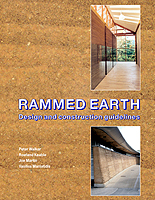
Rammed Earth: Design and Construction Guidelines by Peter Walker and BRE promotes the use of rammed earth wall construction in the UK as a high-quality and sustainable building technology. In one book it gives detailed practical guidance on architectural details, structural engineering recommendations, material selection, construction and maintenance of rammed earth.
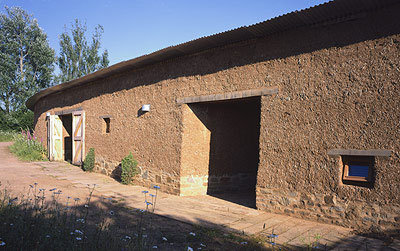
The Cobtun House, Worcestershire, built of mud, straw and corrugated iron, and designed by Associated Architects, has scooped this year’s Royal Institute of British Architects Sustainability Award.
The Earth Building Research Forum was set up by Dr Kevan Heathcote and Mr Gregory Moor in the Faculty of Design Architecture and Building of UTS in December 1999. It was originally envisaged as a forum for disseminating ideas and research into the performance of earth buildings but has since been widened to include a database of earth building projects, information on forthcoming conferences, linkages to other earth building sites and to include more general articles on the subject. The Forum hosted an international earth building conference at UTS in January 2005 (EarthBuild 2005) and this is planned to be a biennial event. The Conference brought together engineers, environmentalists, builders and architects from around the world.
Earthen architecture in Iran and Central Asia: its conservation, management, and relevance to contemporary society, a celebration of the life and work of Robert Byron, will be held at the Institute of Archaeology, University College London, 12-13th November 2005. The aim of the conference is to bring together individuals involved in the conservation and management of the archaeological and architectural legacy of earthen architecture in Iran and Central Asia, to discuss current approaches, practical applications, new projects and the impact of work on local communities and contemporary society.
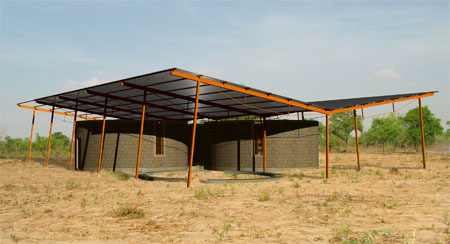
Ronald Rael, an architecture professor at the School of Architecture at Clemson University is working with the Utah based organization, Daily Dose foundation, former NBA player Soumaila Samake and villagers from Tentou, Mali, West Africa to design and build a school for the village’s 400 children using local construction techniques. Download press release (2.2mb .pdf)
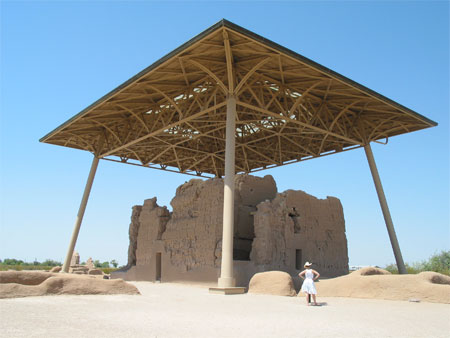
Perhaps nowhere is the blending of modernity and the tradition of earth building more evident than at the Casa Grande Ruins National Monument. Casa Grande was constructed between ad 1200-1450 by the Native American Hohokam near Phoenix, Arizona. In 1928, Frederick Law Olmsted Jr., son of Frederick Law Olmsted the landscape architect most famous for the earthwork of Central Park in New York City, was acting as an adviser to the National Park Service. The desire by the National Park service was to create a shelter that both protected the ruins, while allowing them to have hierarchical presence. The Olmsted Jr. design was completed on December 12, 1932.
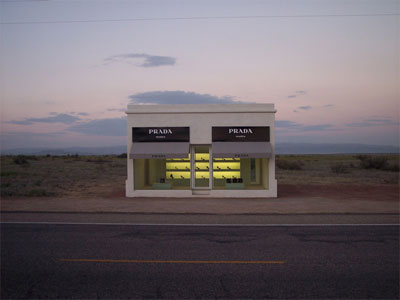
Prada Marfa , an installation by Berlin Based artists Elmgreen and Dragset, is the first Prada-related building in the world constructed of mud-brick. The Art Production Fund and Ballroom Marfa helped fund the project. Architects Ronald Rael and Virginia San Fratello helped the artists realize their vision. [ New York Times | Financial Times | Art Forum | Texas Escapes ]